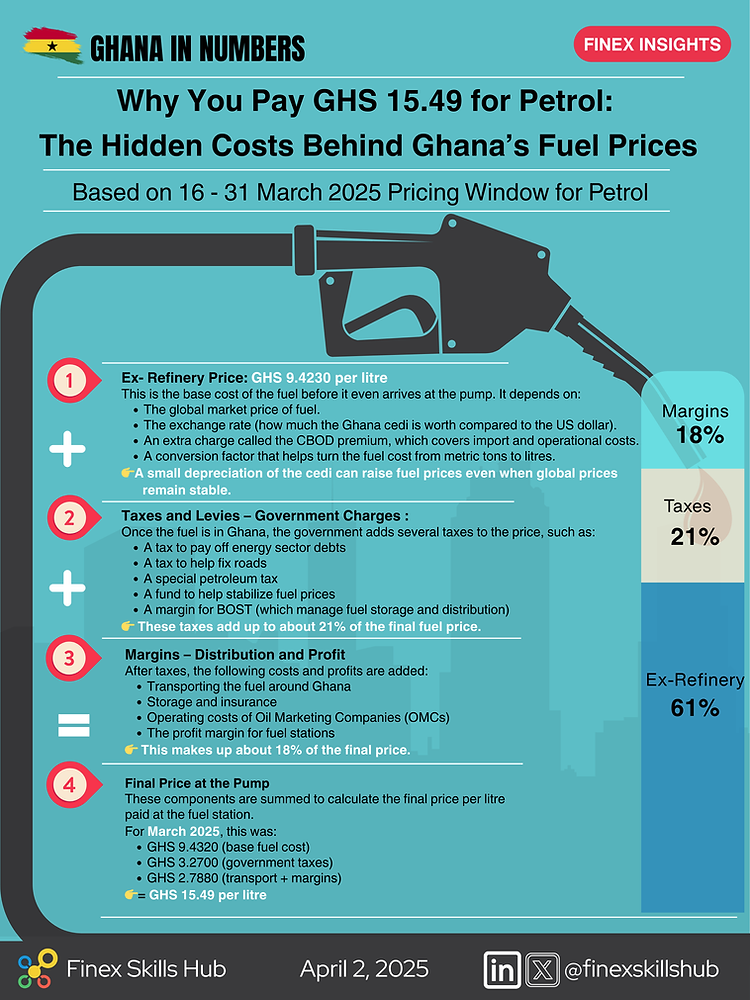
Factors Driving Fuel Prices in Ghana (2000–2025): Trends, Drivers & Policy Insights
Expert analysis of the drivers of Ghana fuel prices from 2000 to 2025: global oil shocks, currency depreciation, subsidy reform, import strategies, and socioeconomic impact.
Highlights:
-
Fuel pump prices rose dramatically—up to 150%+ between 2020–2024.
-
Currency depreciation and global oil shocks are key long-term drivers.
-
Emerging strategies include regional sourcing (e.g., Dangote refinery) and subsidy reform.
Factors Driving Fuel Prices in Ghana: 2000–2025
Highlights
-
Fuel pump prices rose dramatically—up to 150%+ between 2020–2024.
-
Currency depreciation and global oil shocks are key long-term drivers.
-
Emerging strategies include regional sourcing (e.g., Dangote refinery) and subsidy reform.
Research Methodology
This analysis draws on time-series data from authoritative sources—including Bank of Ghana publications, global econometric databases, and verified news reports. Trends were validated through historical pricing metrics, currency fluctuations, fiscal policy changes, and structural shifts in supply.
Top 20 Key Statistics & Facts (2000–2025)
| # | Key Statistic or Fact |
|---|---|
| 1 | Gasoline price low of US$0.20/L in 2000; high of US$1.06/L in 2014. CBOD GhanaReutersTheGlobalEconomy.com+2CEIC Data+2 |
| 2 | Diesel price low of US$0.19/L in 2000; high of US$1.03/L in 2014. TheGlobalEconomy.comenergypedia.info |
| 3 | Average gasoline price ~US$0.98/L between 1990–2025. Trading EconomicsTheGlobalEconomy.com |
| 4 | Ghana gasoline price reached US$1.50/L in mid-2025. Trading EconomicsTradingView |
| 5 | From 2020 to 2024, petrol up ~150%, diesel up ~200%. CBOD Ghana |
| 6 | Petrol and diesel averaged above GHS 13/L in 2024. CBOD Ghana |
| 7 | March 2025 pump price: GHS 15.49 per liter for petrol and diesel. Finex Insights |
| 8 | Brent crude oil price ranged ~US$80–117/barrel in 2022. Bank of Ghana |
| 9 | Petrol indicative monthly average in 2022 ranged from GHS 6.68 to GHS 17.43/L. Bank of Ghana |
| 10 | Diesel indicative monthly average ~GHS 4.91 to GHS 6.79/L across 2021. Bank of Ghana |
| 11 | Ghana abolished fuel subsidies in July 2014. Wikipedia |
| 12 | Cedi depreciated from ~GHS 3.8/USD in 2016 to ~GHS 15–16/USD by late 2024. Wikipedia |
| 13 | By mid-2025, cedi rebounded to ~GHS 10/USD. Wikipedia |
| 14 | Fuel import bill from Europe costs Ghana ~$400 million per month. Reuters |
| 15 | Plan to source fuel from Dangote refinery (Nigeria) to reduce costs. Reuters |
| 16 | Fishers report reduced fishing activity due to fuel price hikes. PMC |
| 17 | Fuel price shocks impact staple food prices, as per an Ashanti region study. ResearchGate |
| 18 | Fuel taxes, margins, and exchange rates major components of pump price formulation. Finex Insights |
| 19 | Ghana’s primary energy import reliance remains high despite local oil production. Wikipedia+1 |
| 20 | Global and local fuel pricing volatility compounds fiscal instability. World Bank |
Body of Article / Critical Analysis
Historical Price Trajectory (2000–2014)
Fuel prices in Ghana started at exceptionally low levels around US$0.20/liter in 2000, driven by periodic subsidy regimes. Through the mid-2000s to 2014, prices increased steadily to reach peaks of US$1.06 for gasoline and US$1.03 for diesel. The doubling and tripling of prices reflected fading subsidies, global oil market dynamics, and administrative pricing formulas. TheGlobalEconomy.com+1
Mid-Decade Developments and Subsidy Removal
In July 2014, Ghana abolished fuel subsidies—a decisive policy pivot that exposed domestic consumers to full global price volatility. This increased price sensitivity in the economy, particularly given sustained currency depreciation. Wikipedia
Inflation and Currency Effects (2016–2024)
Persistent depreciation of the Ghana cedi—from around GHS 3.8/USD in 2016 to a trough of GHS 15–16/USD by late 2024—exacerbated fuel price inflation. Fuel price swings fed through to higher costs of goods and services. Wikipedia
Sharp Fuel Price Surge (2020–2024)
Between 2020 and 2024, domestic petrol and diesel prices surged by roughly 150% and 200%, respectively, reaching over GHS 13/L in late 2024. By March 2025, pump prices stood at GHS 15.49 per liter. CBOD Ghana
Socioeconomic Spillovers
Higher fuel prices have eroded livelihoods, particularly across coastal fishing communities and the agricultural sector. Fisherfolk reported decreased activity and income disruption, while food prices rose sharply in response to fuel cost inflation. PMC
Supply-Side Strategies and Outlook
Ghana’s fuel import bill—averaging US$400 million per month from Europe—remains a heavy fiscal burden. Plans to source from the Dangote refinery in Nigeria, once operational, offer a strategic pathway to lower costs, reduce freight bills, and moderate dependency on European markets. Reuters
Current Top 10 Factors Impacting Fuel Prices in Ghana
-
Global crude oil price volatility.
-
Exchange rate fluctuations (Ghana Cedi vs. USD).
-
Removal or presence of fuel subsidies.
-
Domestic taxes and margin settings in pump price formula.
-
Regional import sourcing and freight costs.
-
Domestic refining and import infrastructure constraints.
-
Policy shifts such as subsidy reforms and pricing deregulation.
-
Socioeconomic shocks (e.g., inflationary pressure, food security).
-
External sourcing opportunities (e.g., Dangote refinery).
-
Structural economic challenges tied to energy import dependency.
Projections & Recommendations
-
Projection: Fuel prices will remain high unless diversified sourcing (e.g., Dangote supply) and exchange stabilization are realized.
-
Recommendation: Accelerate regional import agreements to reduce reliance on European supply chains.
-
Recommendation: Reintroduce targeted subsidy mechanisms or rebates to protect vulnerable sectors while maintaining pricing discipline.
-
Recommendation: Strengthen currency stabilization policies to dampen imported cost pressures and inflation cascades.
Conclusions
Fuel prices in Ghana over 2000–2025 have been shaped by a complex interplay of global oil dynamics, fiscal policy, subsidy regimes, currency depreciation, and structural supply constraints. The period witnessed steep price escalations, particularly between 2020–2025. Strategic policy interventions—especially engaging regional sourcing and improving fiscal buffers—are essential to stabilize fuel costs and safeguard economic resilience.
Notes
-
All prices and statistics relate to published data up to mid-2025.
-
Exchange rates are approximations based on published Bank of Ghana and external estimates.
-
Socioeconomic impacts inferred from localized studies and broader economic reports.
Bibliography & References
-
Ghana gasoline and diesel historical prices data. energypedia.info+2Reuters+2
-
Ghana gasoline price trend to US$1.50/L, mid‑2025. TradingView
-
Surge in fuel prices 2020–2024; pump price data. CBOD GhanaFinex Insights
-
Bank of Ghana commodity and fuel price tracking. Bank of Ghana
-
Abolition of fuel subsidies in 2014. Wikipedia
-
Ghana cedi depreciation trends and recovery. Wikipedia
-
Socioeconomic impacts on fisheries and food prices. Finex Insights+5PMC+5TradingView+5
-
Strategic import sourcing via Dangote refinery. worldbank.org+11Reuters+11Bank of Ghana+11
-
Global fossil fuel pricing and subsidy context. World Bank+1

